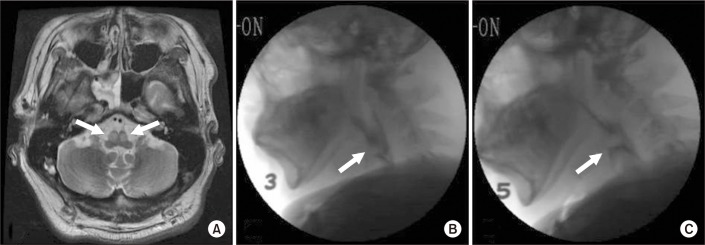Ann Rehabil Med.
2018 Feb;42(1):180-183. 10.5535/arm.2018.42.1.180.
Effectiveness of Combining Behavioral Treatment With Valproic Acid for Dysphagia Caused by Palatal Myoclonus in Patients With Stroke: Two Case Reports
- Affiliations
-
- 1Department of Rehabilitation Medicine, Konkuk University School of Medicine & Konkuk University Medical Center, Seoul, Korea. leej@kuh.ac.kr
- KMID: 2440984
- DOI: http://doi.org/10.5535/arm.2018.42.1.180
Abstract
- Palatal myoclonus (PM) is a rare disease that may induce dysphagia. Since dysphagia related to PM is unique and is characterized by myoclonic movements of the involved muscles, specific treatments are needed for rehabilitation. However, no study has investigated the treatment effectiveness for this condition. Therefore, the aim of this case report was to describe the benefit of combining behavioral treatment with valproic acid administration in patients with dysphagia triggered by PM. The two cases were treated with combined treatment. The outcomes evaluated by videofluoroscopic swallowing studies before and after the treatment showed significant decreases in myoclonic movements and improved swallowing function. We conclude that the combined treatment was effective against dysphagia related to PM.
MeSH Terms
Figure
Reference
-
1. Drysdale AJ, Ansell J, Adeley J. Palato-pharyngo-laryngeal myoclonus: an unusual cause of dysphagia and dysarthria. J Laryngol Otol. 1993; 107:746–747. PMID: 8409734.
Article2. Deuschl G, Toro C, Hallett M. Symptomatic and essential palatal tremor. 2. Differences of palatal movements. Mov Disord. 1994; 9:676–678. PMID: 7845410.
Article3. Hanson B, Ficara A, McQuade M. Bilateral palatal myoclonus: pathophysiology and report of a case. Oral Surg Oral Med Oral Pathol. 1985; 59:479–481. PMID: 3859808.4. Hegland KW. Palatal myoclonus. In : Jones HN, Rosenbek JC, editors. Dysphagia in rare conditions: an encyclopedia. Hong Kong: Plural Publishing;2009. p. 449–454.5. Sumer M. Symptomatic palatal myoclonus: an unusual cause of respiratory difficulty. Acta Neurol Belg. 2001; 101:113–115. PMID: 11486557.6. Goossens D, Guatterie M, Barat M, de Seze M. Palatal myoclonus and dysphagia. Ann Readapt Med Phys. 2004; 47:13–19. PMID: 14967568.7. Juby AG, Shandro P, Emery D. Palato-pharyngo-laryngeal myoclonus: an unusual cause of dysphagia. Age Ageing. 2014; 43:877–879. PMID: 24950689.8. Han TR, Paik NJ, Park JW, Lee EK, Park MS. Standardization of dysphagia diet. Korean J Stroke. 2000; 2:191–195.9. Krings T, Foltys H, Meister IG, Reul J. Hypertrophic olivary degeneration following pontine haemorrhage: hypertensive crisis or cavernous haemangioma bleeding? J Neurol Neurosurg Psychiatry. 2003; 74:797–799. PMID: 12754356.
Article10. Salamon-Murayama N, Russell EJ, Rabin BM. Diagnosis please. Case 17: hypertrophic olivary degeneration secondary to pontine hemorrhage. Radiology. 1999; 213:814–817. PMID: 10580959.



